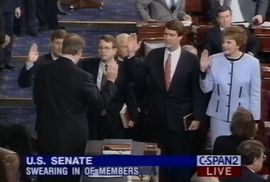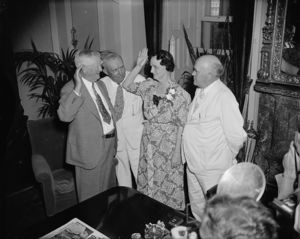
On January 3, 2021, the U.S. Senate will convene to open the 117th Congress. The Senate typically operates according to long-standing rules, traditions, and precedents, and the first day of a new Congress is no exception. The Constitution mandates that Congress convene once each year at noon on January 3, unless the preceding Congress designates a different day.1 In odd-numbered years, following congressional elections, a “new” Congress begins. From 1789 until 1934, a new Congress began on March 4. The Twentieth Amendment, adopted in 1933, changed the opening date to January.
Regardless of the change in date, the first day of a new Congress for the Senate follows a well-established routine—parts of which date back to the first Congress in 1789.
The day begins with the opening prayer and recitation of the Pledge of Allegiance, followed by the swearing-in of senators-elect (and sometimes appointed senators), the establishment of a quorum, notifications to the House of Representatives and the president, and often the election of a president pro tempore and other officers. Unlike the House of Representatives, the Senate, as a continuing body, does not have to adopt or readopt its rules with each new Congress. Article 1, section 3 of the U.S. Constitution provides for staggered six-year terms for senators. The Senate is divided into three classes for election purposes, and every two years only one-third of the senators are elected or reelected, allowing two-thirds to continue serving without interruption.
Before senators-elect can begin exercising their legislative responsibilities, each must present his or her certificate of election and then take the prescribed oath of office in an open session of the Senate. The certificate of election, issued by the governor from the incoming member’s state, confirms that the person was duly elected. Affixed with the state’s official seal, it is delivered to the secretary of the Senate for official recording. After the opening prayer and recitation of the pledge, the vice president of the United States, who serves as the president of the Senate, announces the receipt of certificates. Following established tradition, senators-elect are then escorted down the center aisle of the Senate Chamber to the presiding officer’s desk. Typically, the other senator from the member-elect’s state serves as an escort. Occasionally, the senator-elect chooses an alternative or additional escort, such as a former senator or a family member who also served in the Senate.

The vice president, or, in the vice president’s absence the president pro tempore, administers the oath of office. Senators-elect take the oath to defend the Constitution by raising their right hand and agreeing to the words spoken by the presiding officer:
I do solemnly swear (or affirm) that I will support and defend the Constitution of the United States against all enemies, foreign and domestic; that I will bear true faith and allegiance to the same; that I take this obligation freely, without any mental reservation or purpose of evasion; and that I will well and faithfully discharge the duties of the office on which I am about to enter: So help me God.
Some hold in their left hand a personal Bible or other text of personal significance. The final act in the oath-taking ceremony occurs as the secretary of the Senate invites each newly sworn senator to sign his or her name on a dedicated page in the Senate Oath Book.

Following the official oath-taking ceremony in the Senate Chamber, newly sworn senators join the vice president in the Old Senate Chamber, where they reenact the swearing-in ceremony. Prior to 1987, when the opening day of the Senate was first broadcast on live television, the official swearing-in ceremony was normally off-limits to cameras of any sort. The long-standing ban on photography in the Chamber led newly sworn members to devise an alternative way of capturing this moment for their families, constituents, and posterity. In earlier years, the vice president invited newly sworn senators and their families into his Capitol office for a reenactment for home-state photographers. In 1983 the reenactment ceremony moved to the restored Old Senate Chamber and has been held in that historic setting ever since.
Once the senators-elect have been sworn in, the vice president directs the Senate clerk to call the roll to establish a quorum, which the Constitution requires in order for the Senate to conduct business. The majority leader then moves to adopt resolutions to notify the House and the president that the Senate has a quorum and is ready to proceed. The language of those resolutions has changed very little over the last 230 years. In 1791 the Second Congress convened in Philadelphia. After senators-elect presented their credentials and the vice president administered the oath of office, the Senate passed the following motion:
Ordered, That Messrs. Butler, Morris, and Dickinson, be a committee to wait on the President of the United States, and inform him that a quorum of the Senate is assembled agreeably to the Constitution, and ready to receive any communications he may be pleased to make to the Senate.2
On January 3, 2019, the Senate adopted this resolution:
Resolved, That a committee consisting of two Senators be appointed to join such committee as may be appointed by the House of Representatives to wait upon the President of the United States and inform him that a quorum of each House is assembled and that the Congress is ready to receive any communication he may be pleased to make.3

While the committee members appointed to “wait upon the President of the United States” did so in person in the 18th and 19th centuries, today the committee informs the president by telephone.4
The Senate next proceeds to other administrative business, which often includes the election of the president pro tempore, the secretary of the Senate, the sergeant at arms, and the chaplain. The Senate typically adopts a resolution early in the new Congress to set procedures for operating the Senate during the next two years. The resolution may include committee ratios, committee membership, and other agreements made between the majority and minority parties on the operation of the Senate. This is usually a routine matter approved by unanimous consent agreement, but there have been occasions when the Senate faced unique challenges, making organization difficult. With much of the “housekeeping” out of the way, the Senate is ready to take up legislative and executive business. With each new Congress, all pending legislation and nominations of the previous Congress expire, requiring many bills and resolutions to be reintroduced.

Guests seated in the Senate galleries and those watching from home will note that members often stand behind their Senate desks to deliver their remarks. At the start of each Congress, the desks are reapportioned between the two sides of the Chamber based on the number of senators from the two political parties. For many years, the desks were assigned on a first-come, first-served basis. When a seat became available, the first senator to speak for it won the right to it. Today, at the beginning of each Congress, senators are given the option to change their seats, based on seniority. Three desks that are not assigned in this manner are the Daniel Webster Desk, the Jefferson Davis Desk, and the Henry Clay Desk. Senate resolutions govern the assignment of these desks.
To learn more about the opening day of a new Congress or other Senate traditions, visit Frequently Asked Questions about a New Congress or About Senate Traditions & Symbols.
Notes